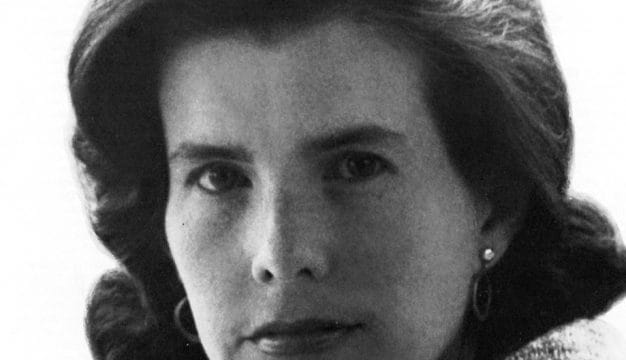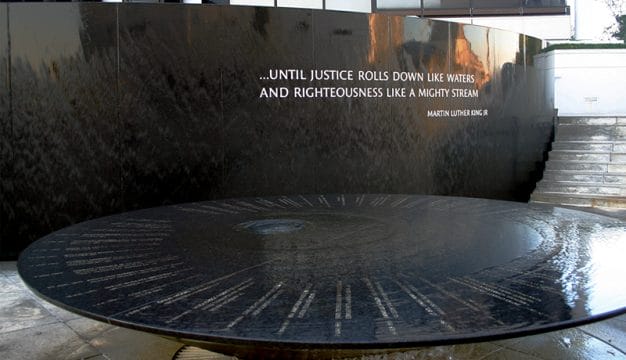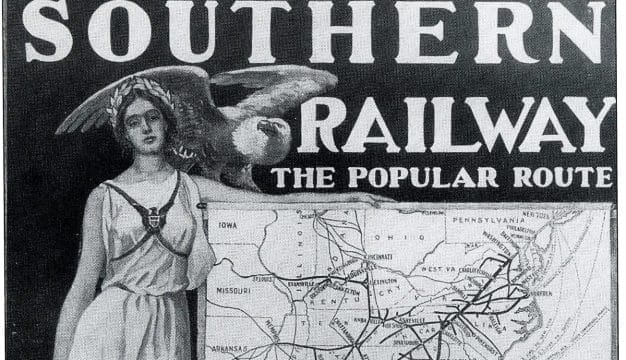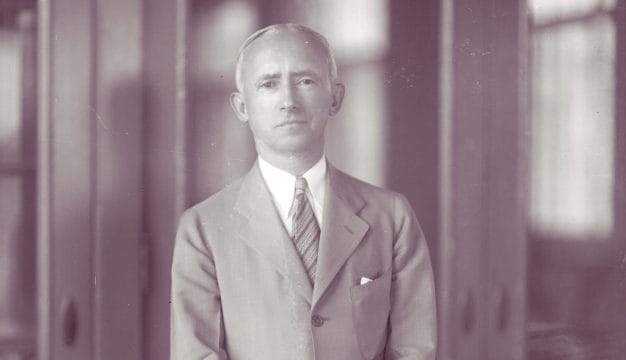NCAA Division I Men's Basketball Tournament
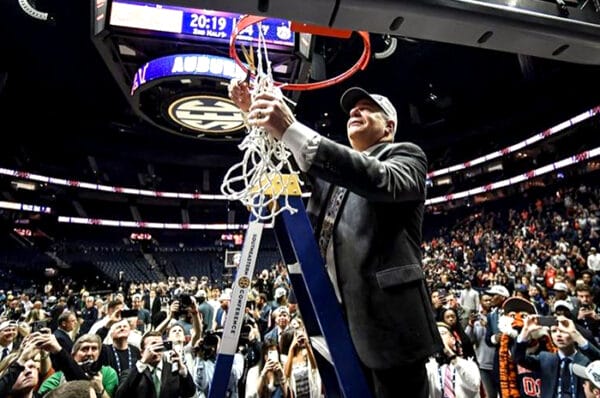 AU Coach Bruce Pearl
The National Collegiate Athletic Association (NCAA) Division I men’s basketball tournament began in 1939, but Alabama schools did not take part in the event until 1975. No Alabama school has won a national championship, and only Auburn University, in 2019, has advanced to the national semifinal, known as the Final Four. The University of Alabama at Birmingham (UAB) in 1982, Auburn University (AU) in 1986, and the University of Alabama (UA) in 2004 have each reached the regional finals, or Elite Eight.
AU Coach Bruce Pearl
The National Collegiate Athletic Association (NCAA) Division I men’s basketball tournament began in 1939, but Alabama schools did not take part in the event until 1975. No Alabama school has won a national championship, and only Auburn University, in 2019, has advanced to the national semifinal, known as the Final Four. The University of Alabama at Birmingham (UAB) in 1982, Auburn University (AU) in 1986, and the University of Alabama (UA) in 2004 have each reached the regional finals, or Elite Eight.
The UA Crimson Tide, in 1975, was the first team from the state to qualify for the tournament. The Crimson Tide has played frequently in the tournament since then, leading the state with 20 appearances through 2019 and reaching the second round of the regional semifinal—Sweet 16—eight times. The UAB Blazers team is second among the state’s largest college basketball programs, with 15 tournament appearances. The Blazers’ first berth came in 1981 in the basketball program’s third year. AU’s first invitation to the tournament came in 1984, and the Auburn Tigers have been in 10 times overall.
University of Alabama
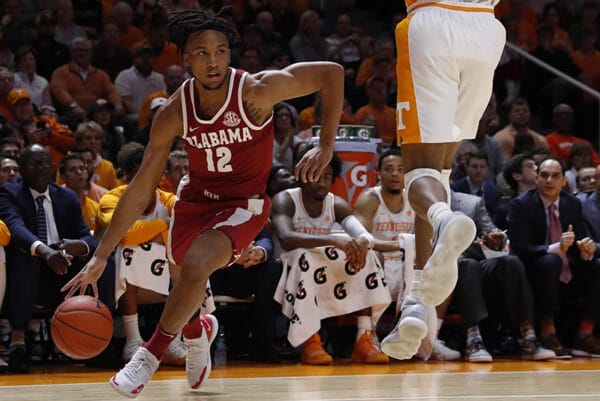 University of Alabama Men’s Basketball
Before the mid-1970s, UA’s Crimson Tide had won only four Southeastern Conference (SEC) basketball championships and had never participated in the NCAA Tournament, not even the legendary “Rocket 8” squad led by Coach Johnny Dee and center-forward Jerry Harper in 1956, which finished 14-0 in SEC play. In 1973, after three losing seasons, Coach Charles M. Newton took Alabama to its first post-season tournament, the National Invitation Tournament, and two years later in 1975, he guided the Tide to the NCAA Tournament. Alabama lost in the first round of the West Regional to Arizona State University, 97-94. Alabama returned to the tournament in 1976 and reached the Sweet 16 for the first time with a team featuring center Leon Douglas, forward Reginald “Mule” King, and guards Theodore Roosevelt “T. R.” Dunn and Anthony Murray. The Crimson Tide defeated the University of North Carolina, coached by Dean Smith, 79-64 in the second round of the Mideast Regional. In the next round, Alabama lost 74-69 against eventual national champion Indiana University, coached by Bobby Knight, in the regional semifinals.
University of Alabama Men’s Basketball
Before the mid-1970s, UA’s Crimson Tide had won only four Southeastern Conference (SEC) basketball championships and had never participated in the NCAA Tournament, not even the legendary “Rocket 8” squad led by Coach Johnny Dee and center-forward Jerry Harper in 1956, which finished 14-0 in SEC play. In 1973, after three losing seasons, Coach Charles M. Newton took Alabama to its first post-season tournament, the National Invitation Tournament, and two years later in 1975, he guided the Tide to the NCAA Tournament. Alabama lost in the first round of the West Regional to Arizona State University, 97-94. Alabama returned to the tournament in 1976 and reached the Sweet 16 for the first time with a team featuring center Leon Douglas, forward Reginald “Mule” King, and guards Theodore Roosevelt “T. R.” Dunn and Anthony Murray. The Crimson Tide defeated the University of North Carolina, coached by Dean Smith, 79-64 in the second round of the Mideast Regional. In the next round, Alabama lost 74-69 against eventual national champion Indiana University, coached by Bobby Knight, in the regional semifinals.
Longtime assistant coach Winfrey “Wimp” Sanderson replaced Newton as Alabama’s head coach in 1981 and began a successful run. In 12 seasons as head coach, Sanderson led Alabama to 10 NCAA Tournament appearances, including six appearances in the Sweet 16. Under Coach David Hobbs, the Crimson Tide played twice in the tournament in 1994 and 1995 but was eliminated in the second round each year. After 1995, Alabama did not appear again in the tournament until 2002 under Coach Mark Gottfried, who had played on three of Alabama’s Sweet 16 teams in the 1980s. Gottfried guided Alabama to the tournament five consecutive seasons from 2002-2006. In 2004, Alabama made its deepest run in the tournament thus far, defeating Southern Illinois University (65-64), Stanford University (70-67), and Syracuse University (80-71) but losing to eventual NCAA champion University of Connecticut 87-71 in the Elite Eight. UA made it to the first round of 2012 NCAA Tournament, losing to Creighton University, 58-57. In 2018, under Coach Avery Johnson, the Tide defeated Virginia Tech 86-83 in the first round and lost to top-seeded and future champions Villanova 81-58 in the second round. With Nate Oates taking over as coach in 2019, a highly ranked Tide team defeated Iowa 68-55 and Maryland 96-77 in the 2021 tournament before losing in the Sweet 16 to the University of California, Los Angeles (UCLA) in overtime 88-78. The team returned to the tournament in 2022 but lost to the Notre Dame Fighting Irish 78-64 in the first round. In 2023, the Tide was the overall top seed in the tournament and breezed through the first two rounds against Texas A&M-Corpus Christie 96-75 and Maryland 73-51 before they were upset in the Sweet 16 by San Diego State 71-64.
Auburn University
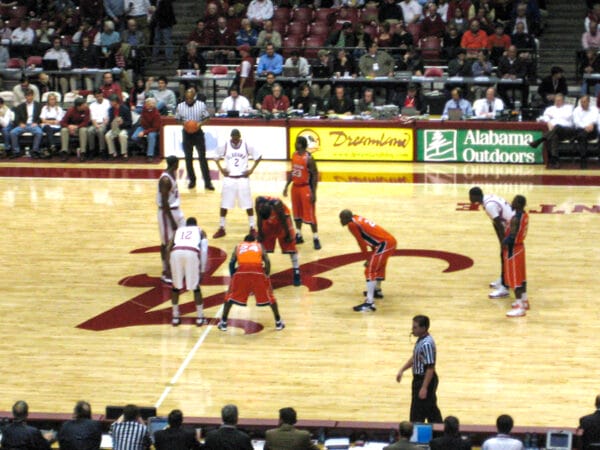 Auburn v. Alabama, 2009
Auburn University first made the NCAA post-season in 1984, led by future National Basketball Association (NBA) stars Charles Barkley and Chuck Person. Although the Tigers were upset 72-71 by the University of Richmond in the first round of the East Regional, the team began a streak of five consecutive NCAA tournament appearances. In 1985, Auburn claimed its first SEC tournament title and returned to the NCAA Tournament, where it advanced to the Sweet 16 by beating Purdue University and the University of Kansas. That victory earned Auburn a return to Birmingham for the regional semifinals, where the team was eliminated 62-56 by the University of North Carolina.
Auburn v. Alabama, 2009
Auburn University first made the NCAA post-season in 1984, led by future National Basketball Association (NBA) stars Charles Barkley and Chuck Person. Although the Tigers were upset 72-71 by the University of Richmond in the first round of the East Regional, the team began a streak of five consecutive NCAA tournament appearances. In 1985, Auburn claimed its first SEC tournament title and returned to the NCAA Tournament, where it advanced to the Sweet 16 by beating Purdue University and the University of Kansas. That victory earned Auburn a return to Birmingham for the regional semifinals, where the team was eliminated 62-56 by the University of North Carolina.
In 1986, Charles H. (Sonny) Smith and the Tigers, led by senior Chuck Person, enjoyed their most successful run in the tournament until 2019. The Tigers advanced to the Elite Eight with victories against the University of Arizona (73-63), St. John’s University (81-65), and the University of Nevada-Las Vegas (70-63). But Auburn was denied a trip to the Final Four, losing a lead in the final minutes and falling 84-76 to eventual NCAA champion University of Louisville.
The Tigers advanced to the tournament again in 1987 and 1988 but were eliminated both years in the second round. Following their streak of five consecutive tournament appearances, the Auburn Tigers went 11 years before returning to the tournament in 1999. Auburn made it to Sweet 16 for the third time but lost to Ohio State University 72-64 in the South Regional semifinals. Auburn returned to the tournament the following season in 2000 but was knocked out in the second round by Iowa State University 79-60. Auburn made it to the Sweet 16 in its next appearance in 2003 but was eliminated in the East Regional semifinals by eventual national champion Syracuse University and star freshman Carmelo Anthony. Auburn returned to the tournament in 2018 under Coach Bruce Pearl, advanced to the second round by defeating the College of Charleston 62-58 and lost to Clemson University 84-53. The 2019 NCAA Tournament was Auburn’s most successful. The SEC-champion Tigers bested New Mexico State in the first round 78-77, overwhelmed the University of Kansas 89-75, and then dominated the top-seeded University of North Carolina 97-80 in the Sweet 16. Auburn defeated conference rival Kentucky in overtime 77-71 in the Elite Eight to advance to the state’s first ever Final Four appearance. There, against the University of Virginia, Auburn lost in the last second 63-62 to the eventual champion Cavaliers. In the 2022 tournament, the highly ranked Tigers defeated Jacksonville State University 80-61 but lost to the University of Miami 79-61 in the second round. In 2023, Auburn again moved to the second round, defeating Iowa 83-75, and then fell in the second round to the University of Houston 81-64.
University of Alabama at Birmingham
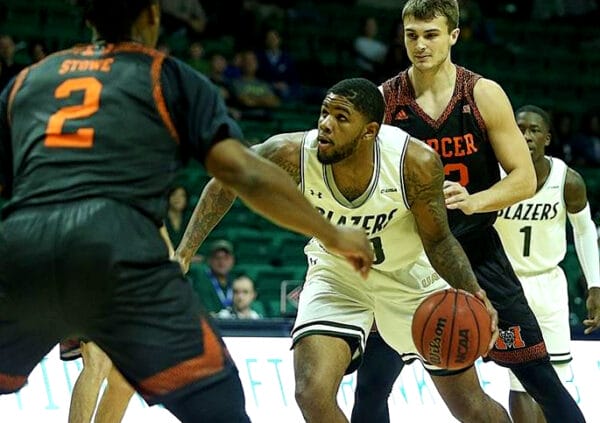 UAB Men’s Basketball
At the end of the 1977 season, UAB lured Coach Gene Bartow away from the University of California-Los Angeles. Bartow quickly brought the new UAB program to prominence. In 1981, just its third year of fielding a team, UAB won the Sun Belt Conference championship to reach the NCAA Tournament, the first of the Blazers’ 13 appearances in the event. The Blazers defeated Western Kentucky University 93-68 in the first round and then upset highly ranked University of Kentucky 69-62 in the second round to reach the Sweet 16. UAB’s NCAA debut ended when it lost 87-72 to eventual national champion Indiana University, led by future NBA star guard Isiah Thomas, on that team’s home court in Bloomington, Indiana.
UAB Men’s Basketball
At the end of the 1977 season, UAB lured Coach Gene Bartow away from the University of California-Los Angeles. Bartow quickly brought the new UAB program to prominence. In 1981, just its third year of fielding a team, UAB won the Sun Belt Conference championship to reach the NCAA Tournament, the first of the Blazers’ 13 appearances in the event. The Blazers defeated Western Kentucky University 93-68 in the first round and then upset highly ranked University of Kentucky 69-62 in the second round to reach the Sweet 16. UAB’s NCAA debut ended when it lost 87-72 to eventual national champion Indiana University, led by future NBA star guard Isiah Thomas, on that team’s home court in Bloomington, Indiana.
In the 1982 season, the Blazers avenged their 1981 loss to Indiana 80-70 in the second round, ending the Hoosiers’ reign as national champs and earning a trip to their home court at the Birmingham-Jefferson Civic Center for the Sweet 16. There, UAB upset the University of Virginia and NCAA Player of the Year center Ralph Sampson, 68-66, to become the first college basketball team from Alabama to advance to the Elite Eight. The Blazers, however, were denied a berth in the Final Four, losing to the University of Louisville 75-68 in the regional final.
UAB made it to the tournament for the next five seasons, extending its streak of consecutive appearances to seven, but the Blazers were eliminated in the first or second round each year. The Blazers made three trips to the tournament in 1990, 1994, and 1999, losing in the first round each year. After a five-year absence from the tournament, UAB made the first of three consecutive appearances under Coach Mike Anderson in 2004. Featuring twins Ronell and Donell Taylor from Montgomery’s Sidney Lanier High School, the Blazers reached the Sweet Sixteen that season before being eliminated by the University of Kansas 100-74 in the St. Louis Regional semifinals. UAB made it to second round in 2005 and was knocked out in the first round in 2006. UAB, in 2011, lost in the first round to Clemson 70-52. In 2015, the Blazers won their first Conference USA championship and returned to the NCAA Tournament, defeating Iowa State in the second round 60-59 and then losing to the University of California-Los Angeles 92-75. The Blazers again secured a tournament bid in 2022 with a conference championship under Coach Andy Kennedy but lost in the first round 82-68 to the University of Houston.
Other Programs
The University of South Alabama has made eight appearances in the NCAA Tournament but with little success, going 1-7 in the tournament thus far. South Alabama’s lone victory came against UA in the first round in 1989. Alabama State University appeared in 2001, 2004, 2009, and 2011, and Samford University and Troy University have each played in two tournaments, in 1999 and 2000, and in 2003 and 2017, respectively. Alabama A&M University lost to Oakland University in its lone Division I appearance, in 2005.
Further Reading
- National Collegiate Athletic Association. March Madness: Cinderellas, Superstars and Champions from the NCAA Men’s Final Four. Chicago: Triumph Books, 2004.
